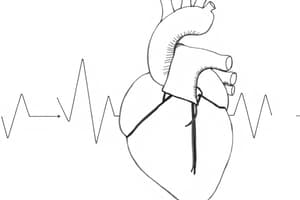Podcast
Questions and Answers
¿Qué es el gasto cardíaco?
¿Qué es el gasto cardíaco?
- La fuerza del músculo cardíaco durante la diástole.
- El número de contracciones cardíacas por minuto.
- La cantidad de oxígeno que el corazón necesita para funcionar.
- La cantidad de sangre bombeada por el corazón en cada contracción. (correct)
¿Cómo se calcula el gasto cardíaco?
¿Cómo se calcula el gasto cardíaco?
- Volumen sistólico multiplicado por la frecuencia cardíaca. (correct)
- Frecuencia cardíaca multiplicada por la presión arterial.
- Volumen sistólico dividido por la presión arterial.
- Presión arterial dividida por el volumen sistólico.
¿Qué es la contractilidad cardíaca?
¿Qué es la contractilidad cardíaca?
- La capacidad del corazón de contraerse rápidamente durante la diástole.
- La resistencia de las arterias al flujo sanguíneo.
- La capacidad del corazón de relajarse completamente durante la sístole.
- La fuerza del músculo cardíaco durante la sístole para bombear sangre. (correct)
¿Qué factores influyen en el gasto cardíaco?
¿Qué factores influyen en el gasto cardíaco?
¿Cuál es el papel de la postcarga en la función cardiaca?
¿Cuál es el papel de la postcarga en la función cardiaca?
¿Qué factor determina el estiramiento del músculo cardíaco antes de contraerse?
¿Qué factor determina el estiramiento del músculo cardíaco antes de contraerse?
¿Qué efecto tienen los preloads más altos en las contracciones cardíacas?
¿Qué efecto tienen los preloads más altos en las contracciones cardíacas?
¿Qué es la postcarga en el contexto de la función cardiovascular?
¿Qué es la postcarga en el contexto de la función cardiovascular?
¿Cómo afecta una postcarga reducida al bombeo cardíaco?
¿Cómo afecta una postcarga reducida al bombeo cardíaco?
¿Cuál es el papel fundamental del contractilidad en la función cardiovascular?
¿Cuál es el papel fundamental del contractilidad en la función cardiovascular?
Study Notes
Cardiovascular Function: Understanding Cardiac Output, Contractility, Preload, and Afterload
The cardiovascular system is responsible for supplying oxygen-rich blood to the body while removing deoxygenated blood. It consists of four chambers of the heart—two atria and two ventricles, which work together with a closed circulatory system that includes arteries, veins, and capillaries. The cardiac cycle involves relaxation (diastole) and contraction (systole). Let's delve deeper into understanding cardiac output, contractility, preload, and afterload as essential components of cardiovascular function.
Cardiac Output
Cardiac output refers to the amount of blood pumped by the heart each minute. It is calculated using the formula:
cardiac output = stroke volume × heart rate
where stroke volume is the amount of blood pushed out from one left ventricular contraction, and heart rate is the number of contractions per minute. Increased demand for oxygen can lead to increased cardiac output through either increasing stroke volume or heart rate.
Contractility
Contractility refers to the strength of the heart muscle during systole—the period when the chambers constrict to push blood through the body. High contractility means the heart muscle contracts strongly, pushing more blood with each beat. The interaction between contractility and workload determines the timing and duration of the heartbeat cycle.
Preload
Preload is the degree of stretching of the heart muscle before it contracts. This stretch is determined by the pressure exerted on the outside of the heart chamber walls due to incoming blood. Higher preloads result in stronger contractions, leading to higher stroke volumes and thus greater cardiac output. However, excessive stretch can cause damage to the heart muscle.
Afterload
Afterload is the resistance that the heart must overcome to force blood forward into the circulatory system. It is influenced by factors such as the diameter of blood vessels, their length, and the elasticity of vessel walls. Reduced afterload allows the heart to pump more efficiently against less opposition. Conversely, increased afterload forces the heart to work harder to maintain adequate flow.
In summary, cardiovascular function involves the coordinated efforts of various heart functions like contractility, preload, and afterload. Understanding these aspects helps medical professionals diagnose and treat cardiovascular diseases effectively.
Studying That Suits You
Use AI to generate personalized quizzes and flashcards to suit your learning preferences.
Description
Aprende sobre conceptos clave de la función cardiovascular, como el gasto cardíaco, contractilidad, precarga y postcarga. Descubre cómo estos elementos influyen en la capacidad del corazón para bombear sangre efectivamente y mantener la salud cardiovascular.




